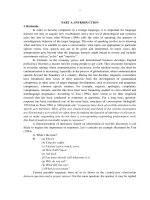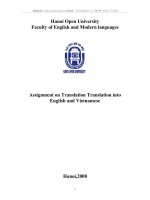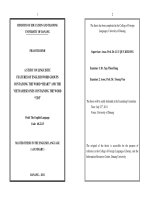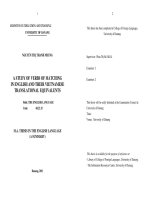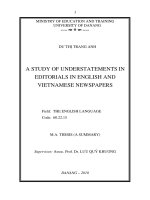SKKN English and physical Education
Bạn đang xem bản rút gọn của tài liệu. Xem và tải ngay bản đầy đủ của tài liệu tại đây (253.21 KB, 8 trang )
Lao Cai High Secondary School for Gifted Students
Group : English and physical Education
S¸ng kiÕn kinh nghiÖm / 2006-2007
Graph writing
Writer : Nguyen Duc Chinh
School year : 2006-2007
I. Prteface
Most Vietnamese students find writing graph difficult , especially the students who use the old text book
, because they are not taught how to write . As a result , only the best students who attend the
contests can write , but sometimes , not very sound . This year, the 10th students who use the new
textbook , are being taught how to write . The number of lessons for teaching writing ,according to the
cirriculum , is not enough. So to help students , and the teachers have some more knowledge , I take
some material from the Net , and hope that it wil bring you some profit .
II. Content
1. How to Write a graph .
In general , you can organize your writing in four or 3 or 4 paragraphs . If you write in 3 paragraphs , you
should put the paragraph 2 and 3 into one paragraph ( It is considered the body of the graph ) , but people
often organize their interpretation in 4 paragraphs . When divided into 4 paragraphs , your writing will be
clear and easy to follow .
1. Paragraph 1
• Identify if the "picture" is a bar graph, line graph, pie chart, table or chart. (This is done in the
opening sentence.)
• Copy out the main part of the question.
• "Tell" about the graphs. (What does it show?)
2. Paragraph 2
• What are the comparisons? (Things that are the same.)
OR
• What are the causes?
• You can simply copy out percentages (%) if shown.
3. Paragraph 3
• What are the contrasts? (Things that are different.)
OR
• What are the effects?
• You can simply copy out percentages if shown.
4. Paragraph 4
• What is your opinion about the causes/effects (comparisons/contrasts) after analysing (looking
at and thinking about) the data (information)?
• Write a conclusion.
2. The structures are used to write a graph .
The
bar graph
line graph
pie graph
state(s)
show(s)
tell(s)
suggest(s)
that
the results of
The
figures
numbers
There was a
(adjective + noun)
small
slight
slow
steady
sharp
sudden
rapid
increase
decrease
rise
fall
The numbers
(verb and adverb)
increased
decreased
doubled
tripled
rose
fell
steeply
suddenly
rapidly
slowly
steadily
normally
gradually
The numbers increased
by
10%
from
10%
to
20%
This is
caused by
due to
an increase in
a decrease
A is
bigger than
more expensive than
cheaper than
much smaller than
slightly larger than
B
increased
decreased
remained the same
fluctuated
The main difference between A and B is
In conclusion
To conclude
In summary
To sum up
As a result
3. Some kinds of graphs
There are many kinds of graphs such as : bar chart, line chart, pie chart, table In general the
layout is the same . The language there is usually passive and comparative .
a/ Example of the bar chart
Bar Chart: Juice Exporters
The chart shows the major exporters of fruit juice in 2002. This type of graph, called a stacked column in
Excel, is not usually recommended, but in this case it is fairly clear.
Try to answer the questions below.
NFC juice is orange juice which is NOT made from concentrate. The juice is packed specially and no water is
added. It is usually better quality and more expensive.
FCOJ is orange juice that has been made into a concentrate. Usually most cheap orange juice has the water
removed in the country where the oranges are grown. This leaves a concentrate, which is frozen and
exported to another country, where the water is added back. The quality is not as good as NFC juice.
Questions:
1. Which country is the biggest exporter of apple juice?
2. Which country is the biggest exporter of orange juice?
3. What is Poland's main juice export?
4. What TWO juices does Argentina export?
5. What was the total value of all orange juice exported in 2002?
6. What is the second most important juice exported worldwide?
7. Which TWO countries produce more than three-quarters of the world's orange juice?
8. The bulk of the world's grapefruit juice comes from which country?
9. Is the European Union (EU) a significant producer of grapefruit juice?
10. How much is China's apple juice production worth in US Dollars, approximately? $_______?
Sample answer .
Bar Chart: Juice Exporters: Suggested Answer
The bar chart shows the value of international exports of four juices - orange, apple, grape and grapefruit –
in 2002. Overall, orange juice, whether in concentrate or non-concentrate form, is the most important juice
traded globally.
Orange juice is a very valuable commodity. Exports of concentrated orange juice and non concentrated juice
totaled approximately $1600 million. This amount is almost twice the value of all other juices together. Three
quarters of this juice is produced in Brazil, which is the biggest producer, and the US.
The second biggest exported juice is apple. This is produced in China, Poland, the European Union, and other
countries. Apple juice sales constituted $600 million dollars a year, with the biggest producer, China,
accounting for about one-third of this.
The remaining juices in the chart are grapefruit, which is produced mainly in the USA, and grape juice, which
is exported by the US, the European Union and Argentina, among other countries. The sales of these juices
are worth $100 million and $200 million respectively.
In conclusion, it is clear that orange juice is by far the most valuable export, but other kinds of juices
represent significant income for exporters.
b/ Example of the line chart
New Zealand Wool Price
Gapfill exercise
Enter your answers in the gaps. When you have entered all the answers, click on the "Check" button.
a peak of fluctuated leveled off rising rose by sharp increase was
In 1980, the price of New Zealand's wool [Clue?] $1.98 per kilo. It then [Clue?] 20
cents in 1981 before falling back to $1.37 in 1986. There was a [Clue?] over the next
two years, with the price of wool reaching [Clue?] $5.13 in 1988. From 1989 to 1993 the
price [Clue?] between a high of $3.20 and a low of $2.75, before [Clue?] to
$4.60 in 1995. After falling again to $3.60 in 1998, the price [Clue?] at $3.55 in 2000.
Age of Marriage
The graph shows changes in the average age of marriage for men and women in the US in the last
century.
Describe the graph in two paragraphs (one for men, one for women) using simple vocabulary (rose
by/rose to, climbed, increased, went up. fell slightly, dropped, decreased).
c/ Example of the pie chart
Single Pie Chart
Paragraph 1
Describe what sort of chart it is and what it is about.
Paragraph 2
Describe the sections of the graph starting with the biggest and working your way down.
Paragraph 3
A short conclusion giving an overall view of what the chart is about. See the model answer of ‘How
Americans Spend their Money'
Two Pie Charts
If you have 2 pie charts they will be giving similar information so you can compare the two. This type of
writing is similar to a compare and contrast essay.
Paragraph 1
Explain that they are pie charts and say what they are describing. This is the same as line graphs except
there are 2.
Paragraph 2
Compare the data between the two charts. Start with the biggest sectors and work your way down.
Paragraph 3
Conclusion. Mention the important similarities and differences. Look at the example for ‘Electrical Energy
Production’
Means of Communication
Write 150 words describing the information in the graph below.
Suggested answer:
The two pie charts illustrate preferred modes of communication for six forms of media in a survey
undertaken in two HD 2 classes, one male and the other female, at ADWC in February 2005. A brief
description follows.
First, the telephone emerges as the most popular mode for males with a proportion of 27%. It ranks almost
as high, at 22% with females, but is tied in their case with text messaging. Text messaging also ranks high
with men, who allot it 1% more. E-mail and instant messenger are close thirds and fourths in popularity,
scoring 17% and 16% respectively for men, 21% and 18% for their counterparts. Last, male students give
the fax only 10%, and letters even less, 7%; females reverse the same percentages.
To conclude, preferences for the six modes of communication are almost identical for the sexes. Both favour
communicating by telephone and text message the most, e-mail and instant messenger the second most,
and letter and fax the least. The only minor difference is that women prefer communicating by letter and
men by fax.
Word count: 179
III Feed back
Afer a year of using the above material , I can see that students are able to write the graphs much
better . I do not see any drawbacks of the material . I hop to receive any opinion contributed to my
experience . Thanks in advance .
Lao Cai 9th September , 2007
Writer : Nguyen Duc Chinh
